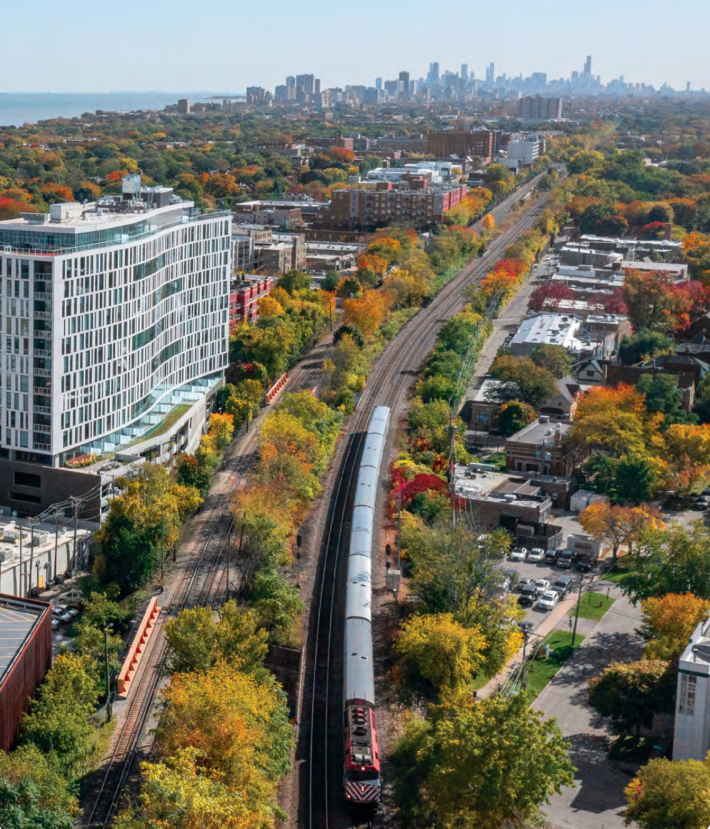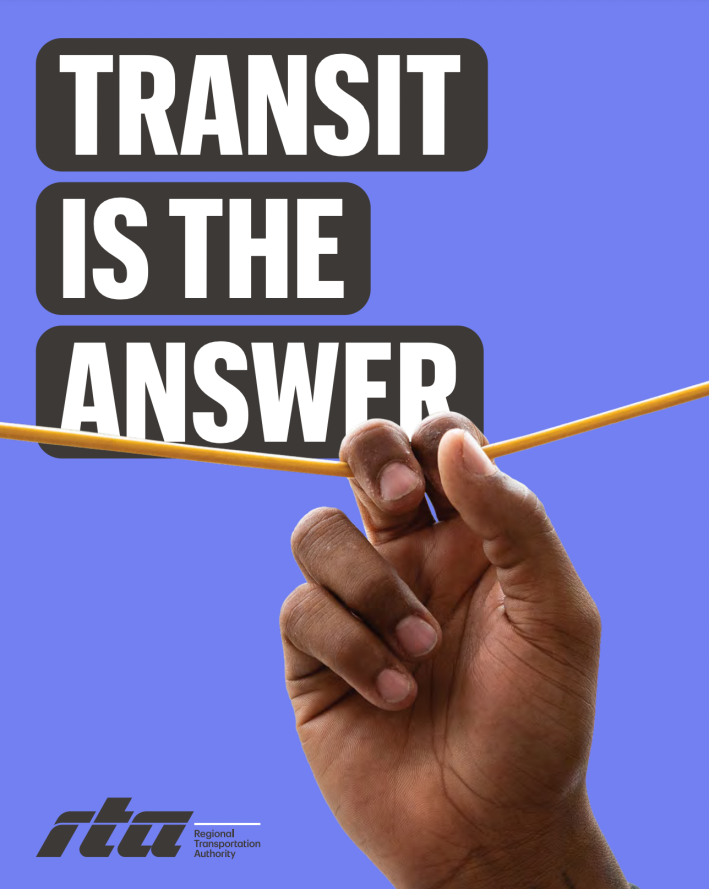As transit systems throughout United States continue to adjust to the life after COVID-19, the Regional Transportation Authority and Metra released strategic plans for the future.
The plans were released literally with a day of each other, Metra on February 15 and RTA on February 16. There is a great deal of overlap between the two. Both aim to make the transit systems more energy-efficient and environmentally friendly. Both want to invest in making train and bus station accessible to people with disabilities and mobility issues. Both put emphasis on racial equity when it comes to capital projects planning, and there is general emphasis on public engagement. But because the two agencies have different missions, the plans have somewhat different priorities.
RTA provides oversight over CTA, Metra and Pace, distributes funding and approves their budgets. With federal stimulus funds scheduled to run out for the free agencies by 2026 (though some will reach the cliff sooner than others), leaving a combined $730 million annual operating budget gap, RTA’s plan focus on laying the groundwork for changing the law governing transit funding. Metra’s plan focuses on how to bring riders back to try to head off that cliff, which means adjusting the service to reflect the changing ridership patterns.
Metra
Out of all the Chicago area transit providers, Metra saw the largest ridership drop at the onset of the pandemic, in large part because the railroad's focus is on transporting commuters to office jobs, whether downtown or in the suburbs. When COVID-19 mitigation measures started to relax, weekend ridership recovered more than weekday ridership, a pattern that still holds to this day. per the strategic plan, the weekday ridership is at around 40% of pre-pandemic levels, while weekend ridership is 60 percent of pre-pandemic levels). This is why, in the past two years, Metra officials increasingly talked about moving away from rush out orientated, still mostly suburb-to-city service pattern.

The strategic plan, "My Metra, Our Future," acknowledges all those issues, as well as the approaching funding crisis facing all transit agencies. The federal stimulus funds that have been using to prop up revenue shortfalls, are expected to run out in 2025, and Metra currently expects its ridership to only reach 70 percent of pre-pandemic levels by that point. It doesn’t help that, like all Illinois transit agencies, Metra is required to get around half of its operations money from farebox revenue. While this requirement was suspended at the onset of the pandemic, it's currently scheduled to kick in again in 2024.
The plan calls for Metra to shift toward more of a regional rail system, with more frequent weekend and off-peak service, and less a Loop-orientated schedule. This was something that advocates from Chicago communities served by the Metra Electric District line have been requesting for decades. The plan also mentions Metra increasing off-peak service frequency on the section of the Union Pacific North line that serves the city and North Shore suburbs (at the expense of stations north of Waukegan) as an example of its future strategy. "We have seen greater ridership recovery [on Union Pacific North line] than any other lines," the plan states.
Another major priority area under the plan is improving rider experience. That includes continuing to work to make stations wheelchair accessible, improving station signage, and adding informational displays with real-time travel info, which are currently only available at a handful of stations.
Metra is also looking to improve the transit experience for commuters who work in the suburbs, such as Amazon warehouse workers. The railroad also want to improve connections with CTA and Pace. Last summer Metra launched a $100 system-wide monthly pass. Combined with the $30 Regional Connect pass add-on, that created what has long been a Chicago transit holy grail: an unlimited monthly pass that works on all RTA modes of transportation. The strategic plan calls for Metra to continue adding ticket machines system-wide, describing that as an opportunity to further improve fare integration “because the machines would accept Ventra Card payments.” That isn’t the same thing as fare integration, but it would make it easier for riders to buy tickets.)

The two remaining priorities are to attract more employees and more generally “be a socially responsible organization committed to equity and sustainability.” The latter included making sure that Metra’s “distribution of [capital] projects throughout the region” is equitable and “includ[ing] community input in the project development process.” Metra projects have historically tended to be a top-down affair, with some residents walking away from input sessions feeling like their input doesn’t actually matter.
(There was a community meeting last April on the Union Pacific North line bridge replacement project in the affluent Lakeview and Lincoln Park neighborhoods, where attendees who were upset with the plan hijacked the hearing, forcing officials to change the format from an open house to a town hall so they could make public comments. But it seems less likely that residents would do that in a lower-income community like Englewood.)
On the diversity hiring front, Metra says it plans to build on what it has already been doing, working with industry associations to encourage more women and people of color to apply for jobs, as well as improving the work environment and addressing pay disparities.
RTA plan
Because the RTA is responsible for funding, oversight and coordination for the CTA, Metra, and Pace, its plan focuses more on funding than operations. It can be divided into two parts, a seven-point point Advocacy Agenda, which focuses on ways to secure more funding for the transit systems, and a seven-point Action Agenda, which deals with service improvement goals and priorities.
RTA and the transit agencies (“service boards” in RTA parlance) fund transit through combination of farebox revenue, sales tax, real estate transfer tax, and various federal and state grants. While the sales tax revenue has been doing better than expected since the start of the pandemic, passenger revenue has been lagging, and the stimulus funding cliff Metra is facing is looming for CTA and Pace as well.
RTA argues that the farebox recovery ratio requirement is outdated and a drag on service boards’ finances. Getting rid of it would require a change in state law, hence the big emphasis on advocacy.
The major advocacy priorities boil down to getting the Illinois General Assembly to at least extend the requirement suspension while RTA works with state legislators and area stakeholders to come up with an alternative. To encourage trust and collaboration, RTA would continue to support local transit-orientated projects and be more transparent about how authority spends its money.
RTA plans to work with the Chicago Department of Transportation, the Illinois Department of Transportation and county transportation departments and divisions within its six-county service area to get signal priority for buses and make highways and roads more suitable for Bus Rapid Transit and Pace's Arterial Rapid Transit (basically BRT-lite) services. Pace previously worked with the Illinois State Toll Highway Authority to develop express bus service on I-90/Jane Addams Memorial Tollway, and the two agencies are currently planning for a similar suburb-to-suburb service along the Tri-State Tollway. The latest IDOT multi-year plan allocated around $11.74 million to rebuild the shoulders of department-operated I-290 and IL 53 highways between Lake Cook Road in Palatine and Des Plaines Avenue in Forest Park, near the Forest Park Blue Line station, which would allow buses to use them in the future the way Pace already does on the Edens and Stevenson expressways. Pace also worked with IDOT to make improvements for the Pulse Milwaukee ART bus.
For the action steps, RTA’s priorities include giving service boards more funds to add security cameras and beef up security staffing, improve accessibility on train stations and bus stops, and improve transit tracking technology. The current transit trackers have had major issues during the pandemic, when there have been transit labosr shortages. CTA’s ghost train/bus issues are well-documented on this blog, Pace’s SMS-based bus tracker info tends to be more reliable than online bus trackers and the displays at the terminals. However, Pace's tracker has gotten better in recent years and, unlike the CTA’s tracker, unstaffed runs are usually clearly marked as “cancelled,” so it has less of a ghost bus problem. Metra recently launched its own train tracker and, in my experience, some actual train runs simply don’t show up on the screen – sort of a Reverse Ghost Train issue.
Other action steps include working to making fares more affordable and inter-service transfers more seamless. The plan also calls for moving towards zero-emissions transit systems; making sure any capital project planning takes racial equity and mobility justice into account; and adjusting transit schedules and service patterns to meet the riders’ needs.
In the statement, RTA board chair Kirk Dillard emphasized that securing more stable, less farebox-dependent funding is a priority that is going to include many entities working together. “The adoption of this plan represents a regionwide united front to meet the challenges facing transit head-on and to make crucial improvements to the system. Our team co-created the plan with more than 100 riders and stakeholders and heard from thousands about their priorities. The result is one of the strongest strategic plans the agency has ever seen, which matches the urgency of this moment for our transit system.”
Metra CEO/Executive director Jim Derwinski agreed. “This new strategic plan recognizes the changes and challenges for public transportation in the post-COVID world and gives us a roadmap for adapting that is practical and flexible,” he said in a statement. “To survive and grow, public transportation will need support from our stakeholders and the public, and this plan will help not only by showing our value to the region but our plan for moving forward.”







